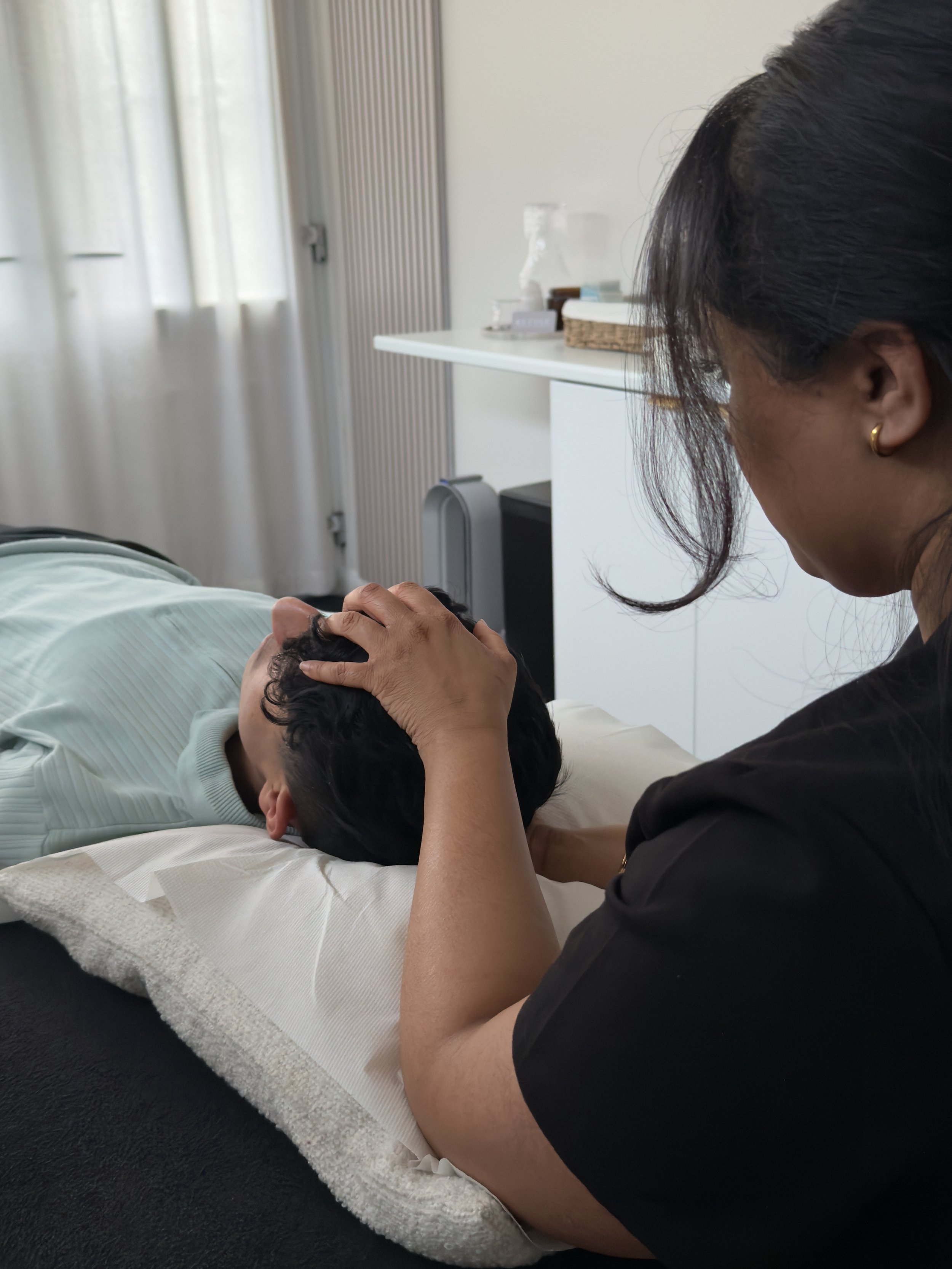
Cranial Osteopathy
A gentle, whole-body approach to calming the nervous system and restoring balance
What Is Cranial Osteopathy?
Cranial osteopathy is a specialist area of osteopathy developed from the work of Dr. William Sutherland, which is very gentle yet deeply effective. Practitioners are trained to detect and release very subtle restrictions and work the rhythmic movement of the cranial bones and body, whilst gaining a sense of the involuntary motion, primary respiratory mechanism, membranes and fluid body, all of which may affect the brain, nervous system and rest of the body systems.
This approach is grounded in the work of Dr. William Sutherland and taught through the Sutherland Cranial College of Osteopathy (SCCO). It’s safe, non-invasive and supports the body’s innate ability to regulate, repair, and heal itself, making it deeply calming when working with sensitive systems such as newborns, pregnant women and those with long standing physical or emotional stress. It’s not limited to the head, despite the name, but instead uses refined palpation skills to gently support the entire nervous system from head to toe.
“The human body carries its history. Cranial osteopathy listens to that history and gently supports the body to release what no longer serves it”
Who is it for?
Cranial Osteopathy for Babies and Children
Feeding difficulties or unsettled behaviour
Tension following a difficult, fast or assisted birth
Reflux, colic, wind, or constipation
Flattening of the head (plagiocephaly), favouring one side
Teething, ear congestion or difficulty sleeping
Cranial Osteopathy for Women
Pregnancy-related tension, pelvic discomfort or anxiety
Emotional and physical postpartum recovery
Hormonal shifts, burnout, and nervous system overload
Cranial Osteopathy for Adults
Headaches, jaw tension or migraines
Sleep issues, anxiety, chronic stress
Emotional or physical trauma held in the body
Longstanding pain that hasn’t responded to other therapies
The Science Behind It
Cranial osteopathy is based on a deep understanding of anatomy, physiology, and the body’s self-healing mechanisms. Research and clinical observations support its use in areas such as:
Paediatrics and birth trauma
Hayden et al. (2006) found improvements in feeding and sleep in infants following osteopathic treatment.
→ Read Study - Complementary Therapies in Clinical PracticeMigraines, headaches and stress-related conditions
Muñoz-Gómez et al. (2022) demonstrated cranial osteopathy reduces pain and improves quality of life in migraines and headaches.
→ Read Study - Journal of Clinical MedicineAutonomic nervous system regulation
Osteopathy in the cranial field has been shown to influence heart rate variability and parasympathetic tone (Henley et al., 2008).
→ Read Study - Osteopathic Medicine and Primary Care
For more on the philosophy and training behind this approach, visit the Sutherland Cranial College of Osteopathy.
What To Expect in A Cranial Osteopathy Session?
Cranial osteopathy is very gentle – there’s no cracking or strong manipulation. You or your child will lie down fully clothed, and I’ll use light hand contacts to feel the body's natural rhythms and guide areas of restriction into release.
During cranial osteopathy treatment , you may:
Feel warmth, tingling or a sense of “unwinding”
Enter a deep state of relaxation
Notice emotional or physical tension melting away
Babies often sleep during or after baby osteopathy treatment, a sign that their nervous system is regulating and healing.
Frequently Asked Questions
-
Yes. Cranial osteopathy is a gentle, non-invasive therapy suitable for all ages, including newborns and pregnant women. It uses light touch to release tension without forceful manipulation.
-
Babies can be seen just a few days after birth. Early treatment may be especially beneficial after a long, fast, or intervention-assisted delivery.
-
Yes. It can ease back pain, pelvic tension, headaches, and help your body adapt to physical and hormonal changes during pregnancy.
-
Yes. By gently releasing tension in a baby’s head, neck, and jaw, cranial osteopathy can improve latching and sucking, making feeding more comfortable for both mother and child.
-
Absolutely. Postnatal sessions can support recovery, ease back and pelvic discomfort, and help restore posture after pregnancy and labour.
-
It varies. Some see improvement after one or two sessions, while others benefit from ongoing care, depending on their needs.
-
For adults, it can help with headaches, jaw pain, stress and posture issues. For babies it may support feeding, sleep, and general comfort, especially after a challenging birth. And for children it may help with posture, aches, developmental or behavioural concerns.
-
The osteopath uses gentle hand placements on the head, spine, or pelvis to assess and release tension. Sessions usually last 45–60 minutes and are tailored to individual needs.
-
Many feel deeply relaxed. Babies may sleep during the session or be more alert afterward, both are normal as the body adjusts. Adults often report reduced pain, better mobility, and improved wellbeing.
-
No. It benefits people at all stages of life, from newborns to older adults and can support recovery from physical strain, stress, or injury.



